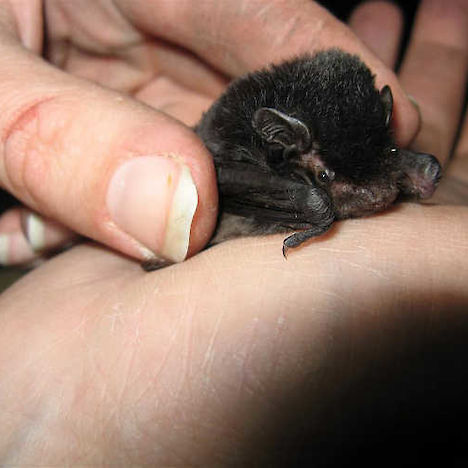Other names:
PekapekaThreat category:
Threatened: Nationally Critical, Threatened: Nationally Vulnerable?Regions:
Northland, Auckland, Waikato, Bay of Plenty, Gisborne, Hawkes Bay, Manawatu-Wanganui, Taranaki, Wellington, Nelson-Tasman, Marlborough, Westcoast, Canterbury, Otago, SouthlandDistribution:
North Island, South Island
Description
- Long-tailed bats have short ears and the tail is linked by a membrane to the forelimbs.
- New Zealand bat species are smaller than a mouse and will fit into the palm of your hand
Taxonomy
- The taxonomy of long-tailed bats is understudied.
- At present, two forms of long-tailed bats are recognised:
- the North Island form, which is classified as Threatened: Nationally Critical; and
- the South Island form, which is classified as Threatened: Nationally Vulnerable.
Interesting Facts
- Bats are the only native land mammals occurring in New Zealand.
- Long-tailed bats roost by day in cavities, splits, and under peeling (or exfoliating) bark of native and exotic trees, large hollow tree stumps, within hollow tree ferns, and in caves or fractures and joints in rocky bluffs.
- Bats are active at night. Bats seen flying at dusk are most likely to be long-tailed bats because they usually emerge from their roosts at this time, whereas short-tailed bats usually emerge later.
- Long-tailed bats navigate and hunt by echolocation, which can sometimes be heard (clicking) without the aid of bat-detectors.
- Long-tailed bats hunt for insects on the wing.
- Long-tailed bats are most often detected flying along habitat edges, such as treelines.
Association with Plantations
- Long-tailed bats use plantation forest in both the North Island and South Island of New Zealand for feeding (foraging), commuting, and to roost in. Long-tailed bats forage over indigenous and exotic forests, open ground and cutover forest.
- Bats have been found roosting within plantation forest stands under peeling bark, in splits or double leaders, or in hollows or cavities in live or dead trees as well as in native tree ferns. At least occasionally bats have been found roosting in slash.
- Long-tailed bats have been found roosting in Pinus radiata as young as 24 years old, and in Eucalyptus species as young as 16 years old.
- There have often been reports of bats being seen when old crop radiata and Douglas fir have been felled.
- They often use forest roads or streams for feeding access.
- Long-tailed bats frequently fly around skid sites at night to feed on insects.
Threats
- Felling of roost trees.
- Habitat loss and degradation through land development.
- Predation of adults and young by cats, mustelids (particularly stoats), possums and rats.
- Current research suggests bats may be susceptible to some toxins, e.g. poison in paste form.
Management Options and Methods
- Identify and protect potential roost trees.
- Protect indigenous forest remnants.
- Undertake possum control to 5% RTC (Residual Trap Catch – see glossary).
- Undertake predator control.
- Pest control priority is to protect roost trees, but avoid the use of poison pastes.
- If other threatened species (e.g. falcon, kereru, or kiwi) are also present and they would benefit from predator control, consider implementing integrated cat, mustelid and rat control.
- Injured or dead bats:
- Place injured or dead bats in a cardboard box (keep cool) and deliver to a local vet, SPCA, or DOC as soon as possible.
- Report all injured or dead bats as soon as possible to the local DOC office during office hours or 0800 DOC HOT (0800 362 468) outside office hours.
Monitoring Options
- Increase staff and contractor knowledge about bats and keep a record of sightings.
- Survey at night using bat detectors. Long-tailed bats prefer to fly along habitat edges, so bat detectors placed along forest edges, roads and tracks, and along streams are most likely to detect long-tailed bats.
- Focus monitoring in areas with mature trees (indigenous or exotic) and sites from where bats have been reported.
- Report findings to DOC national bat database.
Further Information and Support
- Guidance for identifying and managing bats in plantation forests.
- Bats in New Zealand poster.
- Molloy J., Daniel M., O’Donnell C., Lloyd B., and Roberts A. 1995. Bat (Peka Peka) recovery plan (Mystacina, Chalinolobus). Threatened Species Recovery Plan 15. Department of Conservation, Wellington. 25 pp.
- O’Donnell C. 2001. Guidelines for surveying and monitoring long-tailed bat populations using line transects. DOC Science Internal Series 12.
- http://www.doc.govt.nz/our-work/biodiversity-inventory-and-monitoring/bats/
- Pest management – contact DOC or Regional Councils.
- O’Donnell C.F.J. 2001: Advances in New Zealand mammalogy 1990–2000: Long‐tailed bat. Journal of the Royal Society of New Zealand 31: 43-57.
- Borkin K.M., O’Donnell C.F.J., and Parsons S. 2011. Bat colony size reduction coincides with clear-fell harvest operations and high rates of roost loss in plantation forest. Biodiversity and Conservation 20 (14): 3537-3548.
- Borkin K.M. and Parsons S. 2009. Long-tailed bats’ use of a Pinus radiata stand in Kinleith Forest: recommendations for monitoring. New Zealand Journal of Forestry 53 (4): 38-43.
- Borkin K.M. and Parsons S. 2010. Plantation forests are used by the lesser short-tailed bat, Mystacina tuberculata rhyacobia. New Zealand Journal of Zoology 37 (1): 13-17.
- Borkin K.M. and Parsons S. 2010. The importance of exotic plantation forest for the New Zealand long-tailed bat (Chalinolobus tuberculatus). New Zealand Journal of Zoology 37 (1): 35-51.
- Borkin K.M. and Parsons S. 2011. Home range and habitat selection by a threatened bat in exotic plantation forest. Forest Ecology and Management 262: 845-852.
- Borkin K.M. and Parsons S. 2011. Sex-specific roost selection by bats in clearfell harvested plantation forest: improved knowledge advises management. Acta Chiropterologica 13 (2): 373-383.
- Borkin K.M. and Parsons S. 2014. Effects of clear-fell harvest on bat home range. PLoS ONE 9 (1): e86163 doi:10.1371/journal.pone.0086163.


